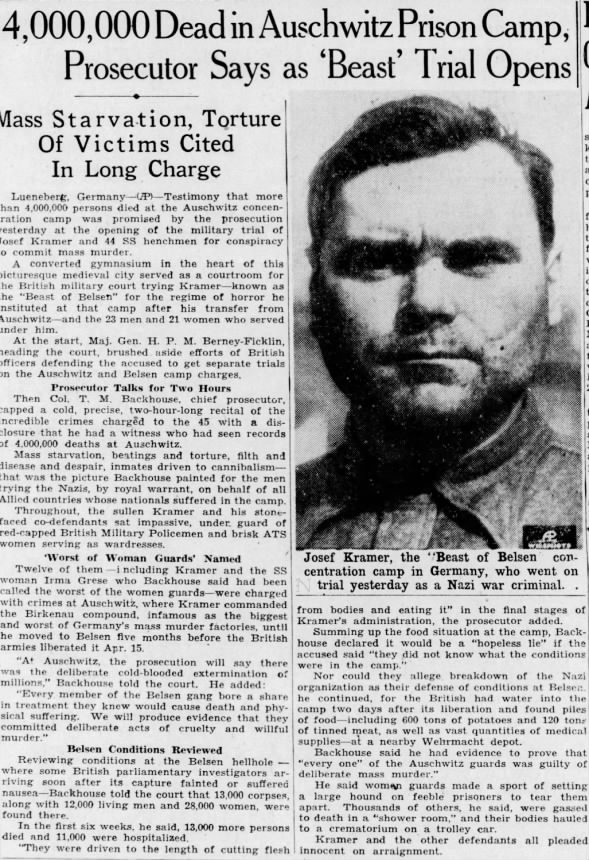- Headline
-
4,000,000 Dead in Auschwitz Prison Camp, Prosecutor Says as 'Beast' Trial Opens
- Sub-Headline
- Mass Starvation, Torture, Of Victims Cited In Long Charge
- Publication Date
- Tuesday, September 18, 1945
- Historical Event
-
First Public Reports on ‘Extermination Camp’ at Auschwitz
This database includes 694 articles about this event - Article Type
- Newspaper
- Page Section and Number
- 3
- Author/Byline
- AP
- Article Text
- Lueneberg, Germany—(AP)—Testimony that more than 4,000,000 persons died at the Auschwitz concentration camp was promised by the prosecution yesterday at the opening of the military trial of Josef Kramer and 44 SS henchmen for conspiracy to commit mass murder.
A converted gymnasium in the heart of this picturesque medieval city served as a courtroom for the British military court trying Kramer—known as the "Beast of Belsen" for the regime of horror he instituted at that camp after his transfer from Auschwitz—and the 23 men and 21 women who served under him.
At the start, Maj. Gen. H. P. M. Berney-Ficklin, heading the court, brushed aside efforts of British officers defending the accused to get separate trials on the Auschwitz and Belsen camp charges.
Prosecutor Talks for Two Hours
Then Col. T. M. Backhouse, chief prosecutor, capped a cold, precise, two-hour-long recital of the incredible crimes charged to the 45 with a disclosure that he had a witness who had seen records of 4,000,000 deaths at Auschwitz.
Mass starvation, beatings and torture, filth and disease and despair, inmates driven to cannibalism—that was the picture Backhouse painted for the men trying the Nazis, by royal warrant, on behalf of all Allied countries whose nationals suffered in the camp.
Throughout, the sullen Kramer and his stone-faced co-defendants sat impassive, under guard of red-capped British Military Policemen and brisk ATS women serving as wardresses.
'Worst of Woman Guards' Named
Twelve of them—including Kramer and the SS woman Irma Grese who Backhouse said had been called the worst of the women guards—were charged with crimes at Auschwitz, where Kramer commanded the Birkenau compound, infamous as the biggest and worst of Germany's mass murder factories, until he moved to Belsen five months before the British armies liberated it Apr. 15.
"At Auschwitz, the prosecution will say there was the deliberate cold-blooded extermination of millions," Backhouse told the court. He added:
"Every member of the Belsen gang bore a share in treatment they knew would cause death and physical suffering. We will produce evidence that they committed deliberate acts of cruelty and willful murder."
Belsen Conditions Reviewed
Reviewing conditions at the Belsen hellhole—where some British parliamentary investigators arriving soon after its capture fainted or suffered nausea—Backhouse told the court that 13,000 corpses, along with 12,000 living men and 28,000 women, were found there.
In the first six weeks, he said, 13,000 more persons died and 11,000 were hospitalized.
"They were driven to the length of cutting flesh
[Image of] Josef Kramer, the "Beast of Belsen concentration camp in Germany, who went on trial yesterday as a Nazi war criminal.
from bodies and eating it" in the final stages of Kramer's administration, the prosecutor added.
Summing up the food situation at the camp, Backhouse declared it would be a "hopeless lie" if the accused said "they did not know what the conditions were in the camp."
Nor could they allege breakdown of the Nazi organization as their defense of conditions at Belsen, he continued, for the British had water into the camp two days after its liberation and found piles of food including 600 tons of potatoes and 120 tons of tinned meat, as well as vast quantities of medical supplies at a nearby Wehrmacht depot.
Backhouse said he had evidence to prove that "every one" of the Auschwitz guards was guilty of deliberate mass murder.
He said women guards made a sport of setting a large hound on feeble prisoners to tear them apart. Thousands of others, he said, were gassed to death in a "shower room," and their bodies hauled to a crematorium on a trolley car.
Kramer and the other defendants all pleaded innocent on arraignment. - History Unfolded Contributor
- Osinachi H.
- Location of Research
- Newspapers.com (https://www.newspapers.com)
Learn More about this Historical Event: First Public Reports on ‘Extermination Camp’ at Auschwitz
- Auschwitz (Encyclopedia Article)
- Auschwitz: Chronology (Encyclopedia Article)
- Auschwitz Report (Timeline of Events)
Bibliography
Berenbaum, Michael, and Yisrael Gutman, eds. Anatomy of the Auschwitz Death Camp. Bloomington: Indiana University Press, in association with the United States Holocaust Memorial Museum, 1998.
Cywinski, Piotr, Piotr Setkiewicz, and Jacek Lachendro. Auschwitz from A to Z: An Illustrated History of the Camp. Oswiecim: Auschwitz-Birkenau State Museum, 2013.
Dlugoborski, Waclaw, et al. Auschwitz, 1940–1945: Central Issues in the History of the Camp. Oswiecim: Auschwitz-Birkenau State Museum, 2000.
Gilbert, Martin. Auschwitz and the Allies. New York: Holt, Rinehart, and Winston, 1981.
Langbein, Hermann. People in Auschwitz. Chapel Hill: University of North Carolina Press, 2004.
Levi, Primo. Survival in Auschwitz: The Nazi Assault on Humanity. New York: Collier Books, 1986.
Neufeld, Michael J., and Michael Berenbaum, editors. The Bombing of Auschwitz: Should the Allies Have Attempted It? New York: St. Martin’s Press, 2000.
Rees, Laurence. Auschwitz: A New History. New York: Public Affairs, 2005.
Swiebocka, Teresa, ed. Auschwitz: A History in Photographs. Bloomington: Indiana University Press; Warsaw: Ksiazka i Wiedza, 1993.
All articles about this event
